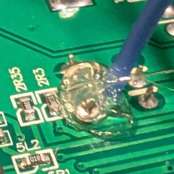[Bjonnh.net]# _
Quick Jupyter Notebook Launcher for KDE
A simple right-click menu option to launch containerized Jupyter notebooks in any directory.
tags kde python

The Akai MPC One is a nice device, but it is a pain to backup if you have to get the SDCard out everytime. Using the SSH mod discovered by TheKikGen, it is easy to connect over ssh and get whatever you need.
tags akai mpc
On using 3d printer screens and controllers for your own projects.
I bought some of those cheap 3d printer controllers on the big evil site for $12: BigTreeTech Mini 12864. There are other similar ones in the same price range from other brands, but I can’t guarantee they have the same pinouts and controllers. Also these came with a tiny yellow rubber duck, always useful when you try to make sense of schematics.

The thing is, these are made for 3d printers so they expect you to plug them directly and not worry about implementation details.
Fun thing is, for some printer models, you need to make an adapter cable as nobody seemed to have settled on a standard for those and pinouts are all over the place.
To save you from the hassle of figuring out how to use those with an Arduino or an ESP, and likely for me later when I will need that again, I decided to write down all I discovered about them.
tags arduino electronics midi
I recently got a WD SN850. There is a little trick to do when you receive it to switch it to 4k LBA and thus getting better performance by using native block size.
tags nvme performance
I finally put my hands on a Trinket M0 for the Trackpoint. Meaning, no more ugly driver.
tags keyboard ergonomic trackpoint arduino
A friend of mine Pierre Grangé-Praderas needed to make a webpage with graphs. So I decided to play with Cytoscape and Hugo and see if I could integrate them together.
tags graph hugo
I spent a day adding a trackPoint to my keyboard to avoid having to move all the time to the trackball. I wanted something that would allow me to quickly jump from one window to another while keeping my hands on the keyboard.
tags keyboard ergonomic trackpoint arduino
Finally, I am trying to reorganize this website, add a portfolio and other kind of stuff that will help me remember the ton of stuff I wrote but never talked about. I’ll document in this article the different kind of things I tried. I am especially excited by the portfolio aspect (of which most will be private though).
tags hugo website
I’m now a heavy user of Draw.io a great piece of Free software from jgraph. However sometimes I need to use it offline… Here is an easy guide on how to use it locally.
tags software diagrams draw.io
I’m moving all my old file-based ssh and gpg keys to a YubiKey 4 hardware key. This post will get updated with a few notes along that migration. It also covers how to use pass and pass-tomb with these. And then I fell down the rabbit hole of using those keys everywhere…
tags gnupg yubikey linux
[Draft published as is, this is old.] I am playing with Pulsar and Heron in Kotlin. And I was always struggling with getting my kotlin project packaged properly. Here is a walk-through.
tags idea kotlin shadow
I was complaining on IRC about someone sending me a screenshot as a word file. Then my friend Aaron Lav had a comment that I turned into that project.
tags spiders python quick-and-dirty
tags ccc cpc conference laser-cutter laser
tags ccc cpc conference laser-cutter laser

I made some new stuff on this project. Now it has a “working” pre-prototype that can do Wifi+RFID+WS2812 Led ring.
tags ESP8266 Wifi GNU/Linux Tutorial

Using magit-status each time or having to type the commands was boring.
tags emacs magit

Today I received an alert from my work email about a mailbox too full.
tags notmuch cleaning

To test the ESP, the Arduino system is good enough. I’ll explain here the steps to install it.
tags ESP8266 Wifi GNU/Linux Tutorial Arduino

I wanted to make a fretless guitar like Vigier of Ron Thal. With a metal fret board. I’m not there yet…
tags Guitar Fretless Hackerspace PumpingStationOne

How to connect the ESP8266 and how to communicate with the default non-free firmware to test the device.
tags ESP8266 Wifi GNU/Linux Tutorial

I just received my ESP8266-12F from Electrodragon. I’m going to document the steps to use that thing on a GNU/Linux machine.
tags ESP8266 Wifi GNU/Linux Tutorial

Tonight, I played with git hooks. Because I wanted to be able to regenerate the website remotely just by doing a push to a specific branch of the website repo.
tags hugo git hooks lazyness
tags rapport son perception

I use Notmuch to manage my emails (and that’s just wonderfully fast) and use the Emacs frontend for it. But when I wanted to save attachements, it was not that easy to create folders. I had to exit the save, open a terminal, a dired or whatever create the folder… I use Helm for managing completion in emacs (and that’s a nice piece of software too).
To avoid that and with the help of Sacha Chua, I managed to add a shortcut in helm read file:
tags emacs helm notmuch
Suite à l’émission de France Inter « Sur les épaules de Darwin, La forme des mots », j’ai décidé d’expérimenter un peu avec la conversion d’images en sons par transformée inverse de fourier.
Pour cela, j’ai utilisé le logiciel ARSS, un peu vieillot, mais qui fait ce qu’il a à faire.
Commençons par un petit exemple, transformons l’image de la formule de cette fameuse transformée en son avec la commande :
tags rapport son perception



















